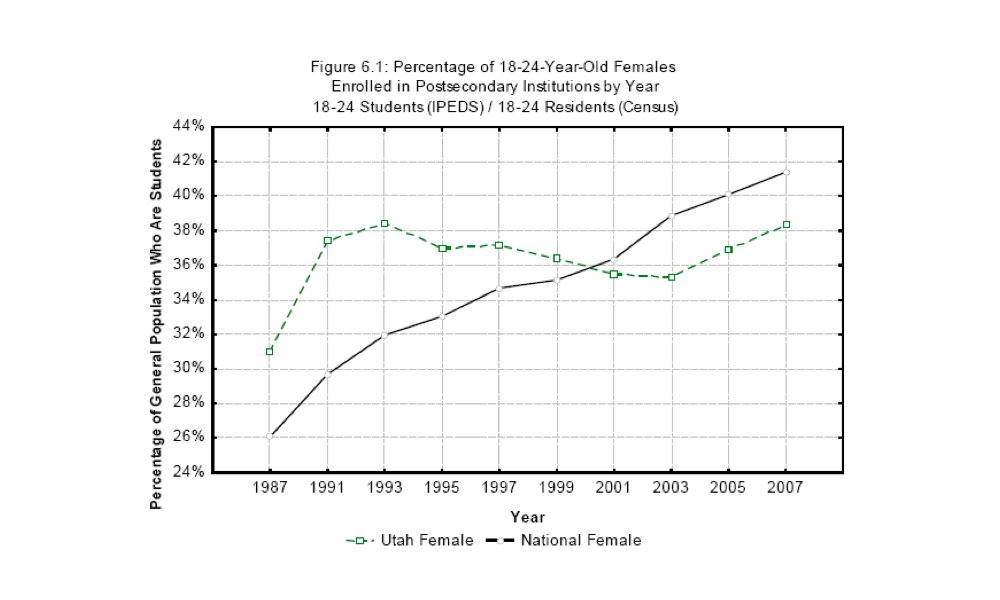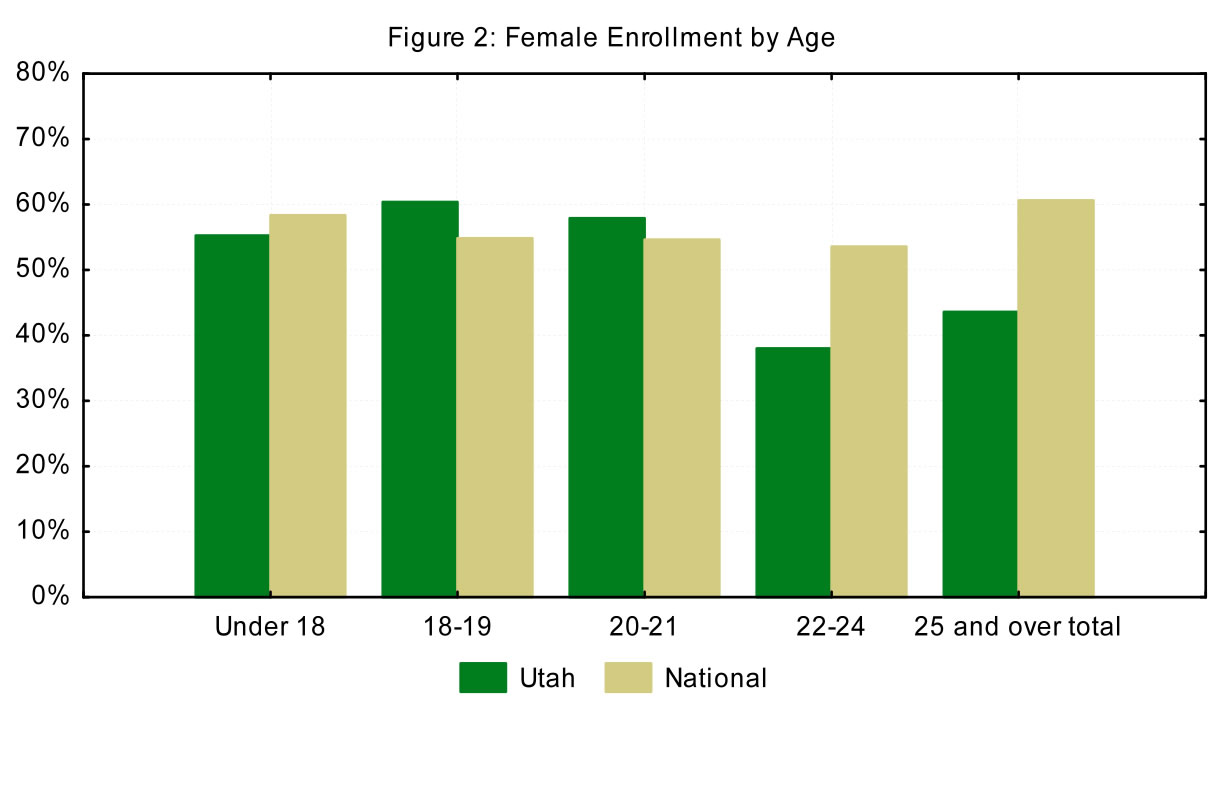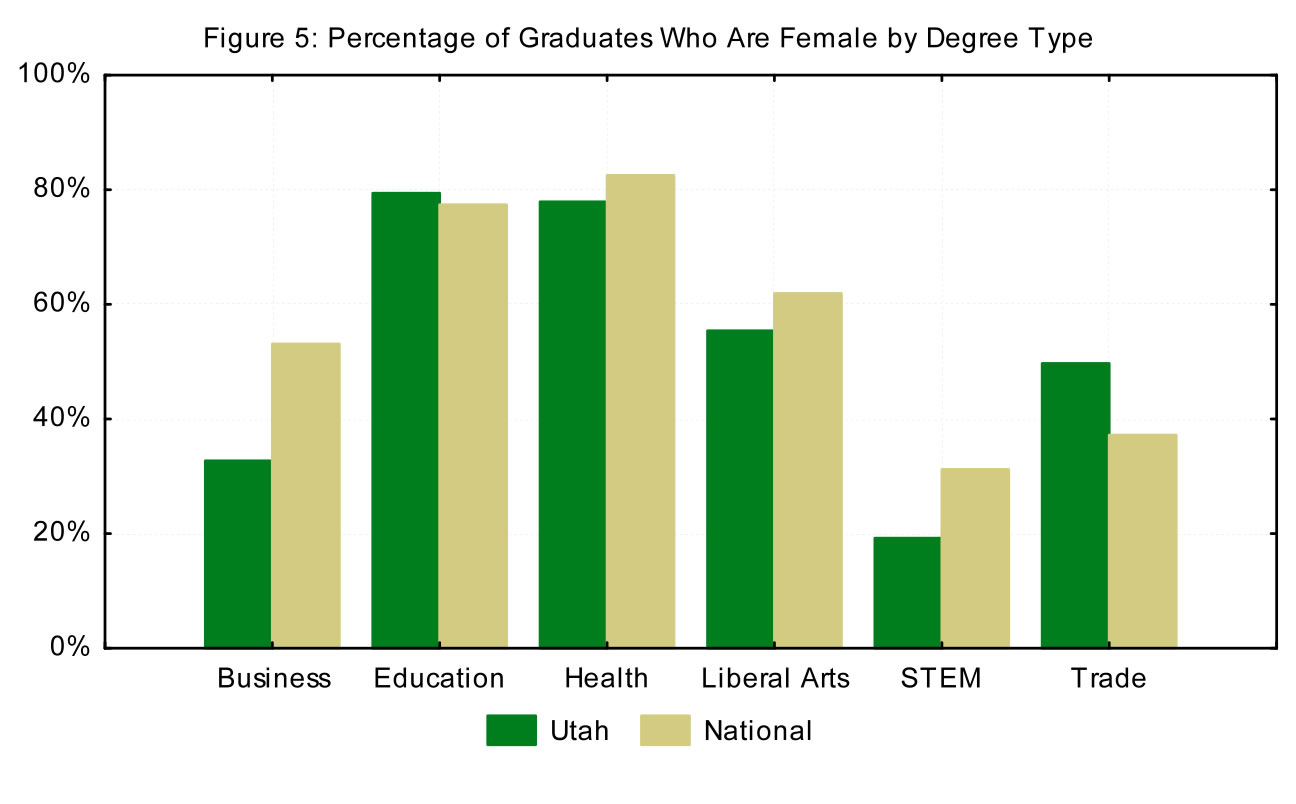"A Glimpse at Women and Higher Education in Utah"
Susan R. Madsen, Cheryl Hanewicz, Susan Thackeray, and David King*
SquareTwo, Vol. 3 No. 3 (Fall 2010)
*This article was taken from sections of the following report: Madsen, S. R., Hanewicz, C., Thackeray, S., & King, A. D. (2010b, May). Women and higher education in Utah: A glimpse of the past and present. Office of the Utah Women and Education Project: Research and Policy Brief, Utah Valley University, Orem, Utah (UWEP 2010-204). Contact Dr. Susan R. Madsen (madsensu@uvu.edu) or visit the Utah Women and Education Project website (www.uvu.edu/wep) if you would like additional information.
Since 1940, Utah has consistently been above the national average in the percentage of adults holding bachelor’s degrees or higher. However, in the last two decades Utah has lost its advantage, and this is particularly true for women in the state. From 1940 to 2000 the educational attainment of Utah women was actually higher than the national average (Utah Foundation, 2009). Conversely, in 2001 Utah women fell below the national average, and the trend has continued. In 1987, approximately 31 percent of the state’s 18–24-year-old female population attended postsecondary institutions (e.g., colleges, universities, and technical schools) compared to only 26 percent nationally (see Figure 1). The participation of Utah women in higher education continued to increase until 1993, when the percentage began decreasing. By 2001 the percentage of Utah women enrolled in postsecondary education decreased to the point that the national percentage surpassed the Utah percentage. It is important to note that the decline in Utah’s ranking is not because fewer Utah women are enrolled in college, but because the percentage of females enrolled in the state declined.
Figure 1: Percentage of 18-24 Year Old Females Enrolled in Higher Education, 1987-2007; Utah in Green, National Average in Black

Historically the number of Utah women with at least a baccalaureate degree had steadily increased, in part because of the population growth within the state. Presently, more Utah women are seeking postsecondary education, but they are not keeping up with their counterparts across the nation (Langston, 2008). Enrollment numbers have been increasing since 2003, but in 2008 they remained 3 percent below the national average of 41.4 percent.
National statistics show that, among those who attend college, more women (57 percent) enroll than men (43 percent). However, in Utah approximately 49 percent of higher education students are women, with the lowest percentages enrolled at the University of Utah (44 percent) and Utah Valley University (43 percent). Compared to all other states, Utah is last in terms of the percentage of female students enrolled in postsecondary institutions. Undergraduate totals are similar, while the numbers are slightly higher for first-time undergraduate females in Utah (51.9 percent). This means that more females are attending college after high school, but they do not stay—enrollment percentages decrease slightly after the first year. In graduate schools, 49 percent of Utah students are women versus 58.8 percent nationally. Utah has a similar disparity in the number of females going to school part-time (50.2 percent) compared to their national counterparts (59.8 percent).
The percentage of female students enrolled in public institutions in Utah by age is unique. Because many young men leave for full-time missions for the Church of Jesus Christ of Latter-day Saints (LDS), the percentage of females enrolled is actually above the national average among 18–21-year-olds (see Figure 2). However, the percentage of females enrolled decreases dramatically in the 22–24 age category, in part due to young men returning to school after their missions. Part of this discrepancy could possibly be explained by Utah women graduating early; however, female graduation rates in Utah are below the national average, suggesting that women leave school without earning a diploma during these years. Hence, the disparity in enrollment by age is best explained by additional males coming into the system and females exiting the system more quickly.
Table 1: Female Enrollment by Age, Utah vs. National Figures

Data also show that Utah females are not enrolling in higher education to complete degrees in high-demand fields that customarily pay well. For example, 28.8 percent of business management and administration students in Utah public institutions are women, compared to 49.5 percent nationally. The two business management programs in Utah System of Higher Education (USHE) institutions with the highest percentage of enrolled females are SUU (35.9 percent) and Dixie (32.9 percent). Programs with the lowest enrollment percentages include UVU (23.3 percent) and the University of Utah (28.7). Interestingly, BYU has the lowest enrollment percentage of all public and private not-for-profits at 21.7 percent, while Western Governor’s University is the highest at 51.6 percent. Biological and life science is also a problematic area, with Utah’s female enrollment falling 19.5 percent below the national average (Utah 40 percent; U.S. 59.5 percent). Conversely, Utah ranks very high in the percentage of females enrolled in education programs. Statistics suggest that women in Utah accept lower-wage jobs that are often low skilled (Langston, 2008). Females who want to maximize their employability, increase their wage earning capabilities, and spend minimal time working outside their home need to consider more advanced training in carefully selected disciplines.
Utah women trail national female graduation rates in all degree categories. National statistics illustrate high female graduation rates; nearly 58 percent of women across the United States graduate from public institutions, while the percentage of Utah women graduating is slightly below 50 percent. Of degrees granted across the nation in any type of institution, 59 percent are given to females compared with 53 percent in Utah when private not-for-profit (e.g., BYU) and other types of institutions are included. For example, private for-profit institutions (e.g., AmeriTech, Eagle Gate, Stevens-Henager, Utah Career) award 60 percent of their degrees to females. Among trade schools, 64 percent of applied technology and 88 percent of cosmetology school graduates are female. There is also a disparity across the board when comparing the downward trend of female graduates moving from associate degrees through doctorate degrees. Women receive 55 percent of all associate’s degrees in Utah, 46 percent of baccalaureates, 49 percent of master’s degrees, and 43 percent of doctorates. A similar drop is seen nationally, but the trend begins at 62 percent for the associate degree.
Utah females are not keeping pace with national trends in the types of degrees they pursue. Utah females trail their national counterparts in all areas outlined except Education and the Trades (see Figure 5). In education, Utah women at public institutions account for 79.4 percent of all graduates compared to the national average of 77.4 percent. This is commendable, since teachers are in demand due to the state’s growing population. Utah females graduating at the bachelor’s level are more likely to earn a degree in education, health, or social services. Interestingly, Utah women enrolled in trade fields account for 49.7 percent of all trade graduates, which is 12.5 percent higher than the national average of 37.2 percent. Utah has high numbers of women earning certificates and degrees in culinary arts and cosmetology. However, in Business, Health, Liberal Arts, and STEM (Science, Technology, Engineering, and Math), Utah women have lower graduation rates than their national peers.

In conclusion, in 1987 the percentages of Utah males and females enrolled in higher education were well above the national average. These percentages for both genders have decreased over time with the female reductions most prominent when compared to the national average. However, looking at the statistics in another way, only 32.1 percent of Utah males 18–24 years old enrolled in postsecondary education compared to 38.3 percent of Utah females. Even with the discrepancy explained partly by the number of Utah males who serve an LDS missions, it is apparent that participation rates for males in Utah should also increase. It is important to note that the higher percentages of women include females in certificate trade programs (e.g., cosmetology, massage, and culinary arts) that are focused on short-term postsecondary training rather than two- and four-year degree programs.
Clearly, women are doing well in many aspects of the postsecondary experience. However, more women in Utah need to make better educational choices and obtain college degrees. Women who want to maximize their employability and increase their wages, as well as mothers who want flexible working schedules in desirable jobs, need to consider more advanced education in high-demand professions. A college degree also has implications well beyond the workplace (Madsen, Hanewicz, & Thackeray, 2010a). A college education for women is important even if she chooses not to work outside the home. Formal education beyond high school is critical as Utah women continue to seek ways to become more competent and influential contributors within their homes, churches, communities, workplaces, and beyond.
REFERENCES
Langston, L. P. (February 2008) The facts about women in Utah. Utah careers supplement for women: A Utah careers publication. Utah Department of Workforce Services. (pp. 12–15). Access at http://jobs.utah.gov/wi/pubs/womencareers/factsheet.pdf .
Madsen, S. R., Hanewicz, C., & Thackeray, S. (2010a, January). The value of higher education for women in Utah. Office of the Utah Women and Education Project: Research and Policy Brief, Utah Valley University, Orem, Utah (UWEP 2010-201).
Utah Foundation (2009, October). Education attainment: Utah falling behind national trends. Utah Foundation Research Brief. Retrieved from http://www.utahfoundation.org/reports/?page_id=532 .
![]()
Full Citation for This Article: Madsen, Susan R., Cheryl Hanewicz, Susan Thackeray, David King (2010) "A Glimpse at Women and Higher Education in Utah," SquareTwo, Vol. 3 No. 3 (Fall), http://squaretwo.org/Sq2ArticleMadsenEducation.html, accessed [give access date].
![]() Would you like to comment on this article? Thoughtful, faithful comments of at least 300 words are welcome. Please submit to SquareTwo.
Would you like to comment on this article? Thoughtful, faithful comments of at least 300 words are welcome. Please submit to SquareTwo.
